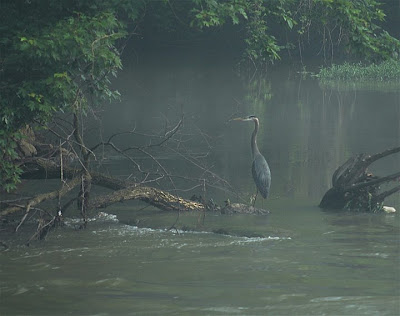
Late this afternoon I took a break from desk work and carried a cup of coffee outside, intending to sit a while on the bench at the end of the deck, watch the water and enjoy the warm sun. As usual, I carried my camera along. After perhaps two sips of much-needed caffeine, I had a thought…why not see what all I could photograph in the space of time it took to finish my cup, and post the results on the blog?
The self-administered contest lasted a half hour. The rules were simple—one lens only (a 70–210mm Nikon zoom, handheld), and no moving off my fanny. As the bench parallels the river, I decided I could only face that direction; no turning around and shooting rearward. I allowed myself to twist or lean, so long as one, er, cheek remained on the wood; but no scooting to get a little closer—I shot what I could shoot from where I sat. Easy enough that even an aging Irishman could manage.
This is what I came up with, pretty much unmanipulated except for cropping…
(Double-click to enlarge.)

Looking straight at the river and the Cottage Pool from the side-deck's bench. You'll notice the wild grape sweeping across the stone steps which lead down to the edge of the river—a persistent vine that encroaches every few days and which I keep at bay by relocating with a broom. By the way, the river is not quite down to pool, and is still discolored from rains last week.
 The first shot I took of sunlight sparkling off a stone in mid-riffle.
The first shot I took of sunlight sparkling off a stone in mid-riffle.
A shot of a single blooming clover in the grass
at the deck's edge.

Orange day lilies blooming along the riverbank about 100 yards upstream.

A mayfly on the cottage's limestone wall.

Hackberry leaves backlighted by the sun; looks like something has been eating on them.

Damselfly on a grape leaf.

Ox-eye daisy at the top of the steps.

The delicate beauty of a common dandelion
gone to seed, at the edge of the bank.

A lost ball that came floating down, over the riffle, looking for a home…

A hen mallard who knew perfectly well where she was, but wanted to see what was going on.

Buzzards winging home as it began to cloud up.

Rowan said in her blog recently that turquoise is her favorite color.
So, Rowan…this bug's for you!

I just missed this one…a bumblebee about to land on a nightshade blossom.
And I almost missed the shot at the top of the post—the one of the blue heron standing at the end of the lower island—because he slipped in on me while I was shooting. To celebrate catching him in his sneaky ways, I took a sip from my cup, which turned out to be the last of my coffee…and thus my little photo contest ended.
















